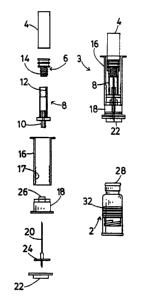Une partie des informations de ce site Web a été fournie par des sources externes. Le gouvernement du Canada n'assume aucune responsabilité concernant la précision, l'actualité ou la fiabilité des informations fournies par les sources externes. Les utilisateurs qui désirent employer cette information devraient consulter directement la source des informations. Le contenu fourni par les sources externes n'est pas assujetti aux exigences sur les langues officielles, la protection des renseignements personnels et l'accessibilité.
L'apparition de différences dans le texte et l'image des Revendications et de l'Abrégé dépend du moment auquel le document est publié. Les textes des Revendications et de l'Abrégé sont affichés :
| (12) Brevet: | (11) CA 2123601 |
|---|---|
| (54) Titre français: | SERINGUE |
| (54) Titre anglais: | SYRINGE |
| Statut: | Réputé périmé |
| (51) Classification internationale des brevets (CIB): |
|
|---|---|
| (72) Inventeurs : |
|
| (73) Titulaires : |
|
| (71) Demandeurs : |
|
| (74) Agent: | BERESKIN & PARR |
| (74) Co-agent: | |
| (45) Délivré: | 2003-06-10 |
| (86) Date de dépôt PCT: | 1992-11-13 |
| (87) Mise à la disponibilité du public: | 1993-05-27 |
| Requête d'examen: | 1999-11-12 |
| Licence disponible: | S.O. |
| (25) Langue des documents déposés: | Anglais |
| Traité de coopération en matière de brevets (PCT): | Oui |
|---|---|
| (86) Numéro de la demande PCT: | PCT/CA1992/000495 |
| (87) Numéro de publication internationale PCT: | WO1993/009825 |
| (85) Entrée nationale: | 1994-05-13 |
| (30) Données de priorité de la demande: | ||||||
|---|---|---|---|---|---|---|
|
A prefilled syringe system is provided for two component pharmaceuticals,
which is a combination of a first subassembly consisting of a capped
bottomless
pharmaceutical vial (2) containing a first component and closed at its bottom
end
by a piston (32) which can be connected to a plunger (16) and a second
subassem-
bly (3) consisting of a shell (4) containing a second component and closed by
a fur-
ther piston (6) and located in telescopable relationship with the plunger, a
cap (18)
which can be forced onto the cap (36) of the bottomless vial, and a double
ended
noodle (320) or a functionally equivalent cannula assembly which is caused to
pierce both pistons as the assemblies are connected by forcing the cap (18)
onto the
bottomless vial, thus placing the vials in communication. The shell vial (4)
is
pressed towards the bottomless vial (2) to express its contents into the
latter, and
the plunger (16) and shell vial {4) are then removed so that the cap (18) and
needle
(20) are left connected to the bottomless vial (2) and the plunger (16) may be
con-
nected to the piston (32) of the bottomless vial to convert it into a syringe.
The shell
vial may telescope either over or within the plunger. In the first case, the
plunger
ads to operate the piston of the shell vial during expression of its contents,
whereas
in the latter case a separate component (8) is required for this purpose.
Note : Les revendications sont présentées dans la langue officielle dans laquelle elles ont été soumises.
Note : Les descriptions sont présentées dans la langue officielle dans laquelle elles ont été soumises.

Pour une meilleure compréhension de l'état de la demande ou brevet qui figure sur cette page, la rubrique Mise en garde , et les descriptions de Brevet , États administratifs , Taxes périodiques et Historique des paiements devraient être consultées.
| Titre | Date |
|---|---|
| Date de délivrance prévu | 2003-06-10 |
| (86) Date de dépôt PCT | 1992-11-13 |
| (87) Date de publication PCT | 1993-05-27 |
| (85) Entrée nationale | 1994-05-13 |
| Requête d'examen | 1999-11-12 |
| (45) Délivré | 2003-06-10 |
| Réputé périmé | 2005-11-14 |
Il n'y a pas d'historique d'abandonnement
Les titulaires actuels et antérieures au dossier sont affichés en ordre alphabétique.
| Titulaires actuels au dossier |
|---|
| DUOJECT MEDICAL SYSTEMS INC. |
| Titulaires antérieures au dossier |
|---|
| REYNOLDS, DAVID L. |